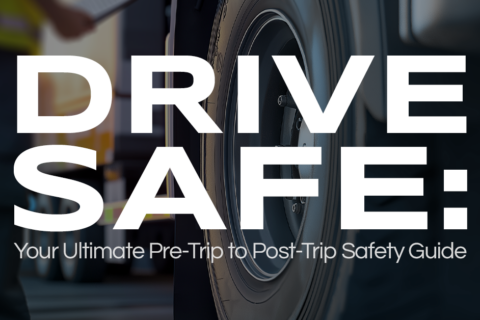Smart Moves: Essential Safety Tips for CDL Drivers and Warehouses
🚛 Safe Hands, Safer Workflows: The Key to Efficient Operations For CDL drivers and warehouse professionals, safety isn’t just a box to check—it’s the backbone of every successful operation. Whether you’re loading pallets or securing a trailer for cross-country hauls, understanding the best practices makes all the difference. In this article, we’ll break down the most effective strategies for loading and unloading safely, giving you tools to protect your team, cargo, and reputation. Let’s explore how to work smarter and safer. 📦 Load It Right: Might Save Your Life There’s no shortcut to loading like a pro—it’s about precision, balance, and planning. Whether you’re hauling fragile goods or hefty equipment, the way you load defines the journey. In this section, we’ll highlight practical techniques for securing cargo, distributing weight, and preventing on-the-road issues. Let’s start with strategies that make safety second nature. 💡 Loaded with Care, Delivered with Confidence Safe loading is more than a task; it’s a mindset. With balanced weight, reliable restraints, and regular checks, you’re reducing risks and increasing efficiency. Want to take it a step further? Start implementing these practices today for safer hauls every time. 🏗️ Unload Like a Pro: Safety First in Every Move Unloading may feel like the final chapter, but it’s one where risks can peak if not managed carefully. Every movement, tool, and team interaction plays a role in maintaining safety and efficiency. This section covers essential tips to ensure every item gets from truck to dock without incident. Let’s make unloading a seamless, safe process. ✨ The Safe Finish: Make Unloading Work for You By treating unloading with the same care as loading, you’re creating a full-circle approach to safety. Alertness, proper gear, and teamwork ensure that every task ends on a high note. Keep these tips in mind and set the tone for smoother operations going forward. 🤝 Team Up for Safety: Collaborative Loading & Unloading Tips No one can do it all alone—not in logistics, not in safety. When drivers and warehouse teams work together, they create safer, more efficient workflows. From clear communication to shared protocols, collaboration is the key to avoiding accidents and staying productive. In this section, we’ll explore joint practices that bring out the best in every team. 🌟 Better Together: Building Safer Workplaces When teamwork drives safety, everyone wins. Strong communication, attention to detail, and mutual respect turn risky situations into manageable routines. Start fostering this collaborative mindset today and experience the difference it makes on every shift. 🎯 Safety Leads the Way: Build Habits for the Long Haul Every safe step taken today builds a stronger tomorrow—for drivers, warehouse workers, and the industry as a whole. By embracing these tips, you’re not just avoiding accidents; you’re setting the standard for excellence in logistics. Share your thoughts below or visit us next week for more insights tailored to keep your operations thriving. Ready to shift your career into high gear? Optimum Staffing Solutions offers a world of opportunities designed to match your ambitions. Whether you’re a veteran CDL driver looking for new roads to conquer, an aspiring recruiter, or an industrial professional eager to innovate in manufacturing, we are here to guide your journey. Picture yourself thriving in roles that range from machine operation and production to leadership and administration. Imagine being part of a team where logistics and warehouse experts, including dispatchers, inventory specialists, and operations managers, work seamlessly to create unparalleled efficiency. Your next career move isn’t just a job; it’s a pathway to success. Join us and let’s drive towards a brighter future together! 🔎 For Businesses Seeking Top-Notch Talent: Finding the right talent can be as complex as navigating the busiest intersections, but Optimum Staffing Solutions simplifies the journey. We are your trusted partner in connecting your business with professionals who excel in their fields and are passionate about driving your success. Whether you need skilled CDL drivers to navigate critical routes, machine operators to maintain production flow, payroll administrators to manage financial efficiency, or healthcare professionals to deliver exceptional patient care, we have you covered. Our curated talent pool includes IT specialists to fortify your tech infrastructure, retail managers to transform customer experiences, and construction project managers ensuring quality infrastructure. With tailored solutions that perfectly fit your business needs, explore our comprehensive staffing services today and discover how we can help keep your operations running smoothly and efficiently. If you’re in search of a role, be sure to check out our open positions. Additionally, if you need direct hire staffing solutions for commercial driving or industrial positions, be sure to explore our offerings. We extend our heartfelt thanks to you for engaging with this post. Safe travels and successful ventures to all our readers. Whether you’re hitting the road or mastering the craft on the manufacturing floor, remember, Optimum Staffing Solutions is here to support your journey every mile and milestone of the way. If you made it to this part of the post, we’d just like to take a moment to thank you for taking the time to read this article. Be safe out there and as always, If you’re in search of a role, be sure to check out our open positions. And if you need staffing solutions for commercial driving or industrial positions, be sure to explore our offerings.











Recent Comments